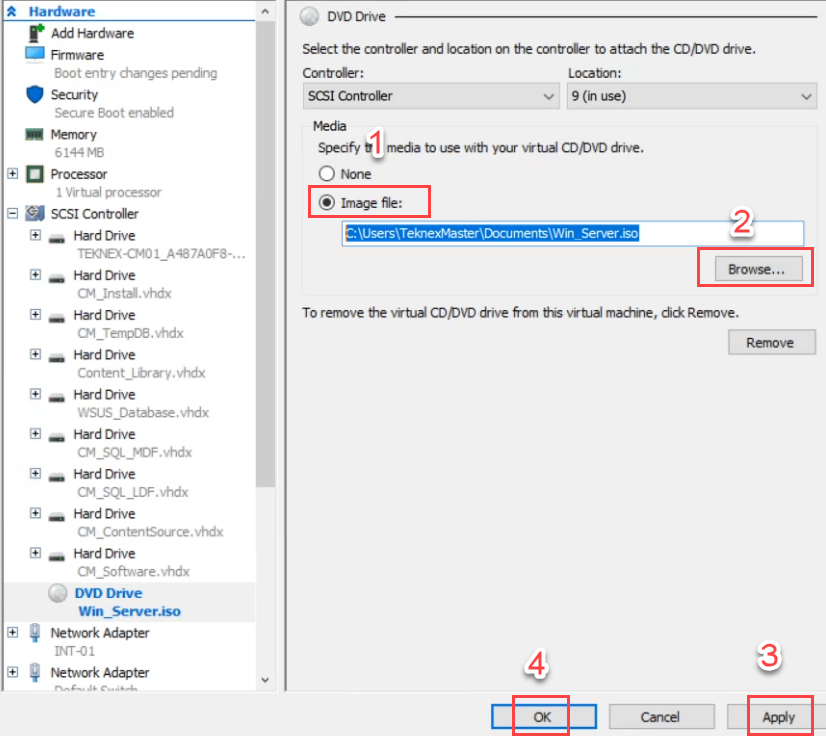
Use yum update form within a Terminal session to install the latest updates. Once your system has been registered, you can use the command line or web console to install the latest updates.
On Hyper-V, select Media from the VM's menu. The VM should then boot from the virtual hard disk. 
Then reset the VM, either through the Machine menu, or using the keyboard shortcut Right CTRL + R (Windows/Linux) or Left Command + R (Mac). If the system has already booted into the installer, you will need to click Force Unmount.
 On VirtualBox, select Devices from the VM's window menu, then select Optical Drives -> Remove disc from virtual drive to eject the installation ISO. Eject the media during POST, or use the appropriate key for your BIOS (such F12, F10, Enter) to select a boot device. Shutdown the system and then restart the system to. If you have a machine (or VM) that reboots too quickly to eject the installation media, you can try: Important note: While your system is rebooting, don’t forget to eject the installation media so that you don’t inadvertently reboot into the RHEL 8 installer again When installation is complete, click Reboot in the lower right corner. Note: When the VM starts, if you can't see the whole screen, you might need to change the Zoom Level to something other than Auto.ĭuring the boot process, do not be alarmed by log messages that briefly flash reporting errors. Start the VM to begin the installation of RHEL 8. If the VM fails to boot the RHEL 8 DVD image, make sure you've changed the secure boot template to Microsoft UEFI Certificate Authority as described above.įinally to start the VM's console, select the VM and select Connect. Creating a Generation 2 VM will avoid the use of legacy hardware emulation. Legacy hardware, like the tulip NIC are no longer supported in RHEL 8. Change Template to Microsoft UEFI Certificate Authority. The option, Enable Secure Boot should be checked. Select the RHEL 8 VM, and select Settings.
On VirtualBox, select Devices from the VM's window menu, then select Optical Drives -> Remove disc from virtual drive to eject the installation ISO. Eject the media during POST, or use the appropriate key for your BIOS (such F12, F10, Enter) to select a boot device. Shutdown the system and then restart the system to. If you have a machine (or VM) that reboots too quickly to eject the installation media, you can try: Important note: While your system is rebooting, don’t forget to eject the installation media so that you don’t inadvertently reboot into the RHEL 8 installer again When installation is complete, click Reboot in the lower right corner. Note: When the VM starts, if you can't see the whole screen, you might need to change the Zoom Level to something other than Auto.ĭuring the boot process, do not be alarmed by log messages that briefly flash reporting errors. Start the VM to begin the installation of RHEL 8. If the VM fails to boot the RHEL 8 DVD image, make sure you've changed the secure boot template to Microsoft UEFI Certificate Authority as described above.įinally to start the VM's console, select the VM and select Connect. Creating a Generation 2 VM will avoid the use of legacy hardware emulation. Legacy hardware, like the tulip NIC are no longer supported in RHEL 8. Change Template to Microsoft UEFI Certificate Authority. The option, Enable Secure Boot should be checked. Select the RHEL 8 VM, and select Settings. 
Next, you will need to change the secure boot settings. iso file you downloaded earlier is selected as the image file.
Install an OS from a bootable image file is selected. 2 or more virtual CPUs are recommended. Network is connected to the default virtual switch or another virtual switch that has external connectivity. Generation 2 to support newer virtualization features. If you don't have the default switch, or prefer a different network configuration, create a new virtual switch and make sure it is attached to the external network.Ĭreate a new VM with the following criteria: Recent versions of Windows have a default switch already created that will give the VM access to the network via NAT. Launch Hyper-V manager to create the RHEL 8 VM.īefore creating the VM, you may need to create a virtual switch.







 0 kommentar(er)
0 kommentar(er)
